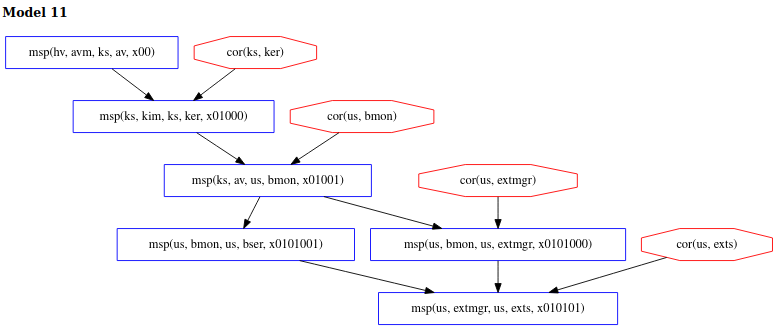Copland
Semantics, languages and tools for layered attestation
- Tampering Paper
- Copland Collection Updated
- CHASE Tutorial Updated
- Maat Released
- CHASE Tutorial Added
- Flexible Mechanisms Paper Published
- Automated Trust Analysis Paper Accepted
- MEMOCODE Paper Accepted
- NFM '21 (Virtual) Conference Presentation
- Copland Collection Released
Publications
Documentation
Software
Blog
Example 3b
*bank: @hv[avm ks av
+<+ @ks[(kim ks ker +<+ av us bmon)
+<+ @us[(bmon us extmgr +~+
bmon us bser) +<+ extmgr us exts]]]
In this example, we introduce an interesting concept. Notice that the Copland phrase is nearly the same as the last example, however, it is now ks that requests the measurement of ker by kim. In addition, the .gln file below now specifies ker as a dependency of kim. Since kim measures ker as specificed in the first measurement in our phrase, we are curious to see what possibilities this creates for the adversary and ultimately, what models Chase finds.
[ bound = 500, limit = 5000, input_order ]
% Assume adversary avoids detection at our main measurement
% event. Others can be added.
l(V) = msp(us, M, us, exts, X)
=> corrupt_at(us, exts, V).
% Assumptions about system dependencies.
depends(us, C, us, extmgr) => C = bser.
depends(ks, C, ks, av) => C = ker.
depends(us, C, us, bmon) => false.
depends(us, C, us, exts) => false.
depends(us, C, us, bser) => false.
depends(ks, C, ks, ker) => false.
depends(ks, C, ks, kim) => C = ker.
depends(ks, C, ks, avm) => false.
depends(hv, C, hv, avm) => false.
% Axioms stating "deep" components cannot be corrupted:
l(V) = cor(hv, M) => false.
% Axioms defining which components cannot be recently corrupted:
% This analysis allows all "recent" corruptions, so there are no axioms here.
m4_include(`ex3b.gli')m4_dnl
m4_include(`ex3b_dist.gli')m4_dnl
m4_include(`thy.gli')m4_dnl
Analysis
Under the given assumptions, Chase yields 40 models. We are most interested
in the models that resemble model 11 below. What makes this model interesting
is the fact that ker can avoid detection at its own measurement since ker is
a dependency of kim. It is important to keep relationships like this in
mind when designing attestation policies.

This concludes the Chase tutorial. Throughout this tutorial we have shown how to use and reason about the Chase models produed using various Copland phrases and under different assumptions. We believe that Chase is a valuable tool that can help policy makers write more robust and useful attestations for their usecases. We have also shown how Chase can be used interactively to reason about the risk and trustworthiness of their attestations. More information on Chase, Copland and the work we’re doing in regards to layered attestation can be found by following the links included in the main README.
Click here to return back to the top.